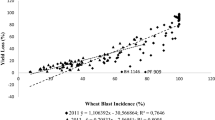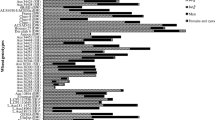Abstract
Reactions of Hordeum chilense accessions H1 and H7 and their amphiploids, HT8, HT9 and HT28 (named as tritordeum) alongwith wheat lines, T22, T24 and T59 used in their synthesis, were studied for resistance to the Karnal bunt pathogen (Tilletia indica) of wheat. Both the accessions of H. chilense and one tritordeum line, HT8, were rated as highly resistant with zero co-efficient of infection, whereas the other two tritordeum lines HT28 and HT9 were rated as moderately susceptible and susceptible with 5.2 and 10.5 co-efficients of infection, respectively, compared to reaction of the wheat lines involved in their synthesis. Karnal bunt infection was maximum on the susceptible wheat cultivar WL-711 with 24.3 co-efficient of infection. All the wheat lines involved in the synthesis of amphiploids were susceptible to Karnal bunt except, T59 (Triticum sphaerococcum) (6X), which showed a moderate level of resistance.
Similar content being viewed by others
References
Agarwal, V.K., H.S. Verma & R.K. Khetarpal, 1977. Occurrence of partial bunt on triticale. FAO Plant Prot Bull 25: 210–211.
Alvarez, J.B., J. Ballesteros, J.A. Sillero & L.M. Martin, 1992. Tritordeum: A new crop of potential importance in the food industry. Hereditas 116: 193–197.
Aujla, S.S., I. Sharma & B.B. Singh, 1989. Rating scale for identifying varieties resistant to Neovossia indica. Indian Phytopath 42: 161–162.
Chauhan, R.S. & B.M. Singh, 1994. Karnal bunt resistance in wheat-barley addition lines. Plant Breed 112: 252–255.
Chauhan, R.S. & B.M. Singh, 1995. Induction of somaclonal variants from different explants of bread wheat for resistance to Karnal bunt (Neovossia indica). Proc Ind Natl Sci Acad B62: 479–486.
Dhiman, J.S. & P.S. Bedi, 1983. A technique for the isolation of Neovossia indica — the causal organism of Karnal bunt of wheat. Indian Phytopath 36: 767–768.
Fuentesdavilla, G., S. Rajaram & G. Singh, 1995. Inheritance of resistance to Karnal bunt (T. indica) in bread wheat (T. aestivum L.). Plant Breed 114: 250–252.
Gill, K.S., A.S. Randhawa, S.S. Aujla, H.S. Dhaliwal, A.S. Grewal & I. Sharma, 1981. Breeding wheat varieties resistant to Karnal bunt. Crop Improv 8: 73–80.
Hoffman, J.A., 1983. Karnal bunt of wheat. Phytopathol 73: 782 (Abstr.).
Islam, A.K.M.R. & K.W. Shepherd, 1992. Production of wheat-barley recombinant chromosomes through induced homeologous pairing. 1. Isolation of recombinants involving barley arms 3HL and 6HL. Theor Appl Genet 83: 489–494.
Martin, A., 1988. Tritordeum: The first ten years. Rachis 7: 2–15.
Nath, R., A.K. Lambat, P.M. Mukewar & I. Rani, 1981. Interceptions of pathogenic fungi on imported seed and planted material. Indian Phytopath 34: 282.
Rubiales, D., J. Ballesteros & A. Martin, 1991. The reaction of X Tritordeum and its Triticum spp. and Hordeum chilense parents to rust diseases. Euphytica 54: 75–81.
Rubiales, D., J. Ballesteros & A. Martin, 1992. Resistance to Septoria tritici in Hordeum chilense × Triticum spp. amphiploids. Plant Breed 109: 281–286.
Rubiales, D., J.K.M. Brown & A. Martin, 1993. Hordeum chilense resistance to powdery mildew and its potential use in cereal breeding. Euphytica 67: 215–220.
Singh, G., S. Rajaram, J. Montoya & G. Fuentesdavilla, 1995. Genetic analysis of resistance to Karnal bunt (T. indica Mitra) in bread wheat. Euphytica 81: 117–120.
Villareal, R.L., G. Fuentesdavilla & A. Mujeebkazi, 1995. Synthetic hexaploids × Triticum aestivum advanced derivatives resistant to Karnal bunt (Tilletia indica Mitra). Cereal Res Commun 23: 127–132.
Warham, E.J., A. Mujeeb-Kazi & V. Rosas, 1986. Karnal bunt (Tilletia indica) resistance screening of Aegilops species and their practical utilization for Triticum aestivum improvement. Can J Plant Pathol 8: 65–70.
Warham, E.J., 1988. Screening for Karnal bunt (Tilletia indica) resistance in wheat, triticale, rye and barley. Can J Pl Path 10: 57–60.
Warham, E.J. & P.A. Burnett, 1990. Influence of media on pathogenicity and morphology of secondary sporidia of T. indica. Pl Dis 74: 525–527.
Zadoks, J.C., T.T. Chang & C.F. Konzak, 1974. A decimal code for the growth stages of cereals. Weeds Res 14: 415–421.
Author information
Authors and Affiliations
Rights and permissions
About this article
Cite this article
Chauhan, R., Singh, B. Resistance to Karnal bunt in Hordeum chilense and its amphiploids with Triticum species. Euphytica 96, 327–330 (1997). https://doi.org/10.1023/A:1003019326395
Issue Date:
DOI: https://doi.org/10.1023/A:1003019326395




